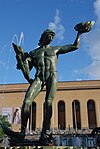Gothenburg City Theatre
- Machine translation, like DeepL or Google Translate, is a useful starting point for translations, but translators must revise errors as necessary and confirm that the translation is accurate, rather than simply copy-pasting machine-translated text into the English Wikipedia.
- Do not translate text that appears unreliable or low-quality. If possible, verify the text with references provided in the foreign-language article.
- You must provide copyright attribution in the edit summary accompanying your translation by providing an interlanguage link to the source of your translation. A model attribution edit summary is
Content in this edit is translated from the existing Swedish Wikipedia article at [[:sv:Göteborgs stadsteater]]; see its history for attribution. - You should also add the template
{{Translated|sv|Göteborgs stadsteater}}to the talk page. - For more guidance, see Wikipedia:Translation.

Gothenburg City Theatre (Swedish: Göteborgs stadsteater) opened in 1934 at Götaplatsen square in Gothenburg, Sweden. The theatre was designed by Swedish architect Carl Bergsten who gave the exterior a Neo-Classical look with a touch of Streamline Moderne. The critics thought it to be a too old-fashioned building – the International Style had had a big breakthrough some years before at the 1930 Stockholm Exhibition. But the interiors of the building pleased the reviewers who thought the auditorium to be "intimate" and “democratic”.[1] The theatre went through a major renovation some years ago and the auditorium was equipped with new technology and with new seats.
The big stage has a capacity of 600 people; there is also a smaller stage called the Studio.
Many of Sweden's big theatre profiles have passed the gates of the theatre: Gösta Ekman (senior) and Ingmar Bergman, just to mention two of them. And during the Second World War Torsten Hammarén made the theatre famous for its anti-Nazi productions.[2] The current leader of the theatre is Anna Takanen and before that it was run by Bosnian-Swedish director Jasenko Selimovic, who during a ten-year period managed to please both audience and theatre critics.
Notes
External links
- Gothenburg City Theatre
- v
- t
- e
- Metropolitan Gothenburg
- Gothenburg
- Hisingen
- Partille
- Mölndal
- Gothenburg Municipality
- Inom Vallgraven
- Canals
- Gothenburg archipelago
- Boroughs and districts
- Port
- Lilla Bommen
- Bohuslän
- Västergötland
- Västra Götaland County
- West Sweden
- Götaland
- Kammarrätten i Göteborg

- Timeline of Gothenburg
- Bragebacken
- William Chalmers
- Comediehuset
- Discothèque fire
- Eriksbergs Mekaniska Verkstad
- Fortifications of Gothenburg
- Gothenburg Riots
- Gothenburg Exhibition
- Kungsporten
- Lindholmen Castle
- New Älvsborg
- Old Älvsborg
- Älvsborg Fortress
- Götheborg
- Sjukhusspionaffären
- Societetsskolan
- Swedish East India Company
- Säröbanan
- Torslanda Airport
- Vauxhall
communications
- Angeredsbron
- Fattighusån
- Central Station
- Göta älvbron
- Kungsportsplatsen
- Götatunneln
- Chalmerstunneln
- Lundbytunneln
- Tingstadstunneln
- Gothenburg tram network
- Västtrafik
- Västtågen
- Landvetter airport
- Säve airport
- Denmark ferry
- Public transport
- West Link
- Commuter rail
- Gårdatunneln
- Lisebergslinjen
- Hisingsbron
- Stombussarna
- Nils Ericson Terminal
- Styr & Ställ
- Marieholmstunneln
- Älvsborg Bridge
- Älvsnabben
streets and parks)
- Allum
- Avenyn
- Backaplan
- Eriksberg
- Frölunda Torg
- Heden
- Nordstan
- Gustaf Adolfs torg
- Järntorget
- Kungstorget
- Kungsgatan
- Linnégatan
- Drottningtorget
- Götaplatsen
- Korsvägen
- Kungsportsplatsen
- Brunnsparken
- Bältesspännarparken
- Botanical Garden
- Ramberget
- Slottsskogen
- Feskekôrka
- Vinga Lighthouse
- Wieselgrensplatsen
- Garden Society
- Delsjön
and entertainment)
- Barken Viking
- Bergakungen
- Draken
- Palladium
- Göteborgs Konsthall
- Museum of Art
- Röhsska Museum
- Gamla Ullevi
- Ullevi
- Scandinavium
- Frihamnen
- Liseberg
- The Göteborg Opera
- Stora teatern
- City Theatre
- City Museum
- Röda sten
- Universeum
- Museum of World Culture
cultural events
- Gothia Cup
- Gothenburg Culture Festival
- Gothenburg Book Fair
- Partille Cup
- Gothenburg Film Festival
- Hammarkullekarnevalen
- Swedish Exhibition and Congress Centre
 Main category
Main category
57°41′52.73″N 11°58′48.86″E / 57.6979806°N 11.9802389°E / 57.6979806; 11.9802389












